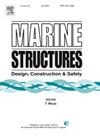考虑技术故障评估船舶对桥梁影响的概率框架:来自巴尔的摩事故案例研究的见解
IF 5.1
2区 工程技术
Q1 ENGINEERING, CIVIL
引用次数: 0
摘要
本文提出了一种新的评估船舶与桥梁碰撞风险的概率方法,特别关注涉及集装箱船达利和巴尔的摩弗朗西斯斯科特基桥倒塌的事件。目前的风险模型有很大的局限性,特别是考虑到导航实践的发展和超精确定位系统的采用。该方法将船舶技术故障分为电源中断、主机故障和舵机故障三大类,提高了预测能力。利用NTPro 6000全任务桥模拟器对大理事件进行了基于模拟的重建。这种重构构成了对四个关键部分进行深入分析的基础:(1)事故可能的技术原因;(2)船桥相互作用风险特征的关键利益相关者及其影响因素;(3)减轻桥梁罢工事件的工程和程序选择;(4)专家评估可行的预防措施,特别是可供海上引航员使用的措施。该研究包括对海事专业人员(包括飞行员和船长)的针对性调查结果。调查的目的是评价目前预防性协议的有效性,并查明在紧急情况下培训、协调和技术反应方面的潜在差距。研究结果为密闭水域的海上事故动态提供了有价值的见解,并提出了一种结构化的方法,通过使用现实故障场景和专家信息分析来增强风险评估方法。本文章由计算机程序翻译,如有差异,请以英文原文为准。
A probabilistic framework for assessing vessel impact on bridges considering technical failures: insights from the Baltimore accident case study
This article presents new probabilistic approach to assessing the risk of collisions between ships and bridges, focusing specifically on the incident involving the container ship Dali and the collapse of the Francis Scott Key Bridge in Baltimore. Current risk models are significantly limited, particularly given the evolution of navigation practices and the adoption of ultra-precise positioning systems. The proposed method enhances predictive capability by incorporating three categories of technical ship failure: loss of power supply, failure of the main engine, and malfunction of the steering gear. A simulation-based reconstruction of the Dali incident was conducted using the NTPro 6000 full-mission bridge simulator. This reconstruction forms the basis for an in-depth analysis of four critical components: (1) the probable technical cause(s) of the accident; (2) key stakeholders and influencing factors in the risk profile of ship-to-bridge interactions; (3) engineering and procedural options for mitigating bridge strike incidents; and (4) expert assessment of feasible preventive measures, particularly those available to maritime pilots. The study includes the results of a targeted survey of maritime professionals, including pilots and captains. The survey aimed to evaluate the effectiveness of current preventive protocols and to identify potential gaps in training, coordination, and technical response in emergency situations. The findings provide valuable insights into the dynamics of maritime accidents in confined waters and propose a structured approach to enhancing risk assessment methodologies through the use of realistic failure scenarios and expert-informed analysis.
求助全文
通过发布文献求助,成功后即可免费获取论文全文。
去求助
来源期刊

Marine Structures
工程技术-工程:海洋
CiteScore
8.70
自引率
7.70%
发文量
157
审稿时长
6.4 months
期刊介绍:
This journal aims to provide a medium for presentation and discussion of the latest developments in research, design, fabrication and in-service experience relating to marine structures, i.e., all structures of steel, concrete, light alloy or composite construction having an interface with the sea, including ships, fixed and mobile offshore platforms, submarine and submersibles, pipelines, subsea systems for shallow and deep ocean operations and coastal structures such as piers.
 求助内容:
求助内容: 应助结果提醒方式:
应助结果提醒方式:


